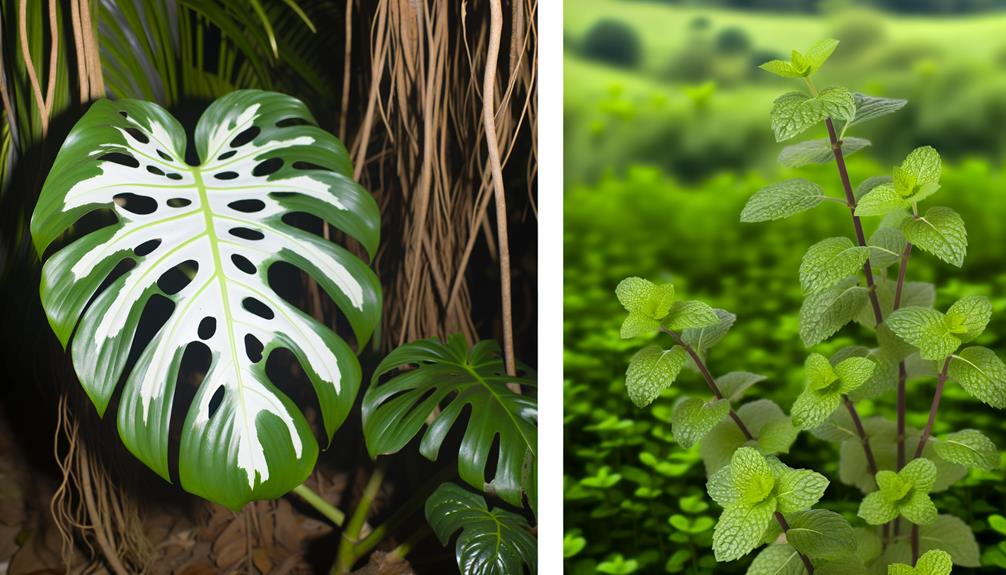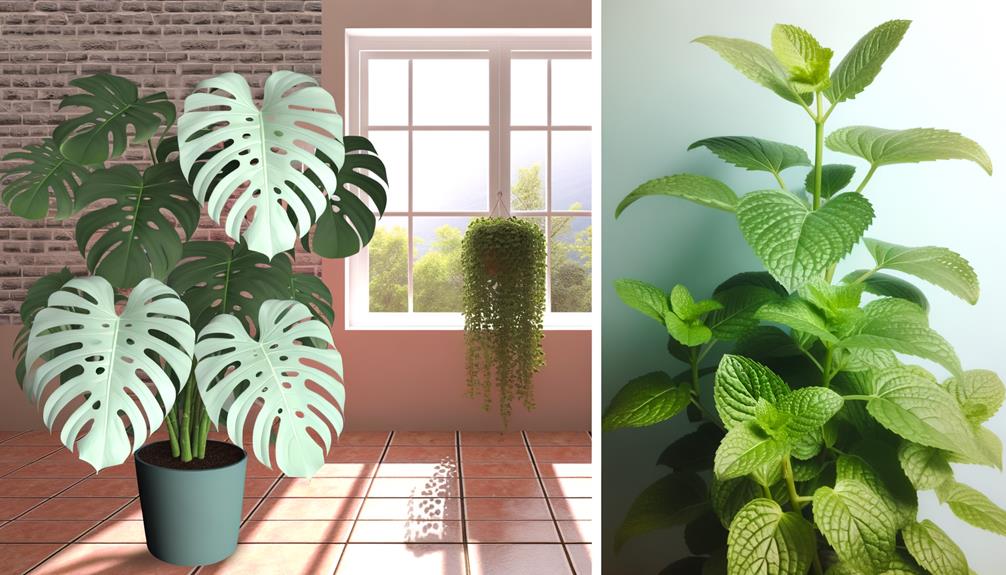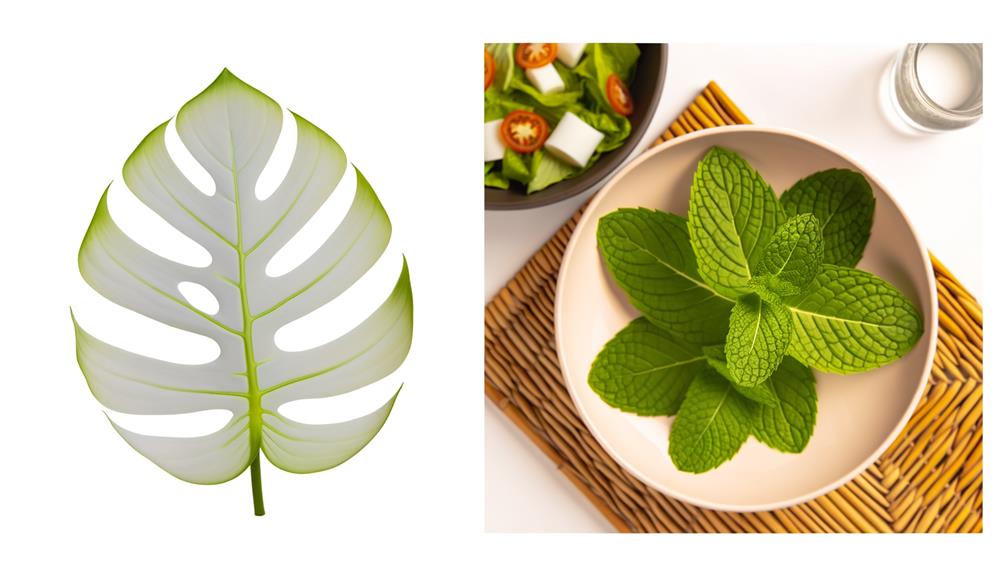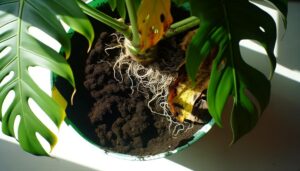What Is the Difference Between Monstera White Monster and Mint?
Monstera White Monster and Mint differ significantly. Monstera White Monster, from Central American rainforests, showcases striking white variegation on large green leaves and grows using aerial roots.
In contrast, Mint, from temperate regions across Europe, Asia, and North America, presents a solid mint-green hue and spreads via stolons. Monstera thrives in bright, indirect light and well-draining soil, while Mint prefers full sun and nutrient-rich soil.
Monstera is valued for its ornamental foliage, whereas Mint is prized for its culinary and medicinal uses. Both plants are susceptible to pests and diseases like spider mites and root rot.
Discover further distinctions for a detailed understanding.
Comparison of Monstera White Monster and Monstera Mint
| Feature | Monstera White Monster | Monstera Mint |
|---|---|---|
| Scientific Name | Monstera deliciosa ‘Albo Variegata’ | Monstera deliciosa ‘Mint Variegata’ |
| Common Name | White Monster | Mint Variegata Monstera |
| Leaf Shape | Heart-shaped with deep fenestrations | Heart-shaped with deep fenestrations |
| Leaf Texture | Smooth | Smooth |
| Leaf Color | Green with white variegation | Green with mint-green variegation |
| Variegation Pattern | Irregular, patches and splashes | Irregular, patches and splashes |
| Growth Habit | Climbing vine | Climbing vine |
| Mature Size | Up to 10-15 feet indoors | Up to 10-15 feet indoors |
| Light Needs | Bright, indirect light | Bright, indirect light |
| Watering | Keep soil moist but not waterlogged | Keep soil moist but not waterlogged |
| Temperature | Prefers 65-85°F (18-29°C) | Prefers 65-85°F (18-29°C) |
| Humidity | High humidity (above 60%) | High humidity (above 60%) |
| Soil Type | Well-draining, rich potting mix | Well-draining, rich potting mix |
| Propagation | Stem cuttings | Stem cuttings |
| Toxicity | Toxic to pets and humans | Toxic to pets and humans |
| Special Care | Regular misting and occasional fertilizing | Regular misting and occasional fertilizing |

Origin

The Monstera White Monster and Mint both originate from distinct botanical lineages, with the former being a cultivar of Monstera deliciosa and the latter belonging to the Mentha genus.
You’ll find that Monstera deliciosa hails from the tropical rainforests of Central America, thriving in humid, shaded environments. This epiphytic species uses aerial roots to climb trees, maximizing light exposure.
In contrast, Mint species are native to temperate regions across Europe, Asia, and North America. They’re herbaceous perennials, growing vigorously in moist, well-drained soils. Unlike Monstera, Mint propagates via stolons, allowing rapid ground coverage.
Understanding these origins helps you appreciate their differing care requirements, ecological adaptations, and potential uses in horticulture and cuisine.
Appearance
When examining the appearance of Monstera White Monster and Mint, you’ll notice distinct differences in leaf color patterns and variegation characteristics.
Monstera White Monster exhibits striking white variegation against green foliage, while Mint displays a more subtle, mint-green hue with less pronounced variegation.
Additionally, you’ll find that Monstera White Monster typically grows larger in size compared to the more compact Mint.
Leaf Color Patterns
Monstera White Monster displays striking variegation with white and green patches, whereas Mint Monstera features a subtler, mint-green shade interspersed with darker green.
When examining these plants, you’ll notice key distinctions in their leaf color patterns:
- Variegation Distribution: White Monster showcases irregular, asymmetrical patches of white, creating a dramatic contrast with its green areas. Mint Monstera, however, displays a more uniform, blended pattern of mint-green and darker green.
- Color Intensity: The white in White Monster is stark and vivid, often covering large leaf sections. Mint Monstera’s colors are muted, with softer progressions between shades.
- Pattern Consistency: White Monster’s variegation can vary significantly from leaf to leaf, while Mint Monstera maintains a more consistent color distribution across its foliage.
Variegation Characteristics
Examining the variegation characteristics reveals distinct differences in the pattern, distribution, and overall appearance between White Monster and Mint Monstera leaves.
White Monster typically exhibits stable, well-defined variegation with large, irregular white patches scattered throughout the leaf surface. This variegation often appears in a marbled or sectoral pattern, providing a striking contrast against the green.
In contrast, Mint Monstera showcases a more subtle variegation, characterized by lighter green or cream-colored areas that blend softly with the primary green tissue. The variegation in Mint Monstera tends to be more evenly distributed, resulting in a speckled or dappled effect rather than large patches.
These differences in variegation make each cultivar uniquely appealing to collectors and enthusiasts.
Plant Size Differences
In addition to their variegation characteristics, White Monster and Mint Monstera also display noticeable differences in plant size and overall appearance.
When examining these two Monstera varieties, you’ll find:
- Leaf Size: White Monster typically has larger leaves, often reaching up to 3 feet in length, while Mint Monstera’s leaves are more moderate, around 2 feet.
- Growth Habit: White Monster displays a more vigorous, sprawling growth pattern, necessitating ample space and support. Conversely, Mint Monstera grows more compactly, making it suitable for smaller spaces.
- Stem Thickness: The White Monster possesses thicker, more robust stems, providing structural stability for its expansive leaves. In contrast, Mint Monstera has relatively slender stems, aligning with its more compact growth.
Understanding these distinctions helps you choose the right Monstera for your space and preferences.
Growth Requirements

Understanding the growth requirements for both the White Monster and Mint varieties involves detailed attention to their specific light, water, and soil needs.
The Monstera White Monster thrives in bright, indirect light, benefiting from well-draining, peat-based soil with a pH of 5.5–7.0. It requires moderate watering, ensuring the soil remains moist but not waterlogged.
Conversely, Mint (Mentha spp.) prefers full sun to partial shade and flourishes in well-drained, nutrient-rich soil with a pH of 6.0–7.0. Mint demands consistent moisture to avoid wilting, but you must prevent waterlogging.
Both plants have distinct requirements, so you should tailor your care regimen to meet these specific conditions to support ideal growth.
Care Tips
When caring for Monstera White Monster and Mint, you’ll need to understand their specific watering and humidity needs, light requirements, and ideal soil and fertilizer conditions.
Make sure you’re providing consistent moisture levels suited to each plant’s physiology and maintaining appropriate humidity.
Additionally, it’s essential to position them in the correct lighting environment and use the right soil composition and nutrients to support their growth.
Watering and Humidity Needs
Both Monstera White Monster and Mint require consistent moisture levels, but their specific watering and humidity needs differ considerably due to their unique physiological traits. Monstera White Monster thrives in high-humidity environments, typically above 60%, and prefers its soil to be evenly moist but not waterlogged.
In contrast, Mint is more tolerant of varying humidity levels but needs frequent watering to keep the soil consistently damp.
To ensure optimal growth for each plant, follow these guidelines:
- Monstera White Monster: Maintain humidity with a humidifier or regular misting.
- Mint: Water daily during the growing season; reduce frequency in cooler months.
- Soil: Use well-draining potting mix for Monstera; nutrient-rich, slightly acidic soil for Mint.
These practices cater to their distinct hydration and environmental needs.
Light Requirements
While maintaining appropriate moisture levels is key, providing the right light conditions is equally essential for the health and vigor of Monstera White Monster and Mint.
Monstera White Monster thrives in bright, indirect light. Direct sunlight can scorch its leaves, causing discoloration. Conversely, Mint prefers full sun to partial shade but can tolerate lower light conditions.
Here’s a quick comparison:
| Plant | Light Preference | Notes |
|---|---|---|
| Monstera White Monster | Bright, indirect light | Avoid direct sunlight to prevent leaf burn. |
| Mint | Full sun to partial shade | Can adapt to lower light, but growth slows. |
Ensuring optimal light exposure not only enhances photosynthesis but also prevents etiolation, promoting strong and healthy growth.
Soil and Fertilizer
Proper soil composition and balanced fertilization are necessary for the optimal growth of both Monstera White Monster and Mint. For Monstera, use well-draining soil rich in organic matter. A combination of peat, perlite, and orchid bark works effectively.
Mint thrives in loamy, nutrient-rich soil with good drainage. Fertilization should be tailored to each plant’s requirements.
- Monstera White Monster: Use a balanced 20-20-20 liquid fertilizer monthly during the growing season.
- Mint: Apply a balanced fertilizer, such as 10-10-10, once every 6-8 weeks.
- Soil pH: Make sure Monstera soil pH is slightly acidic (5.5-7), while Mint prefers a neutral pH (6-7).
Uses

In horticulture, Monstera White Monster is primarily cultivated for its ornamental foliage, whereas mint is prized for its culinary and medicinal applications.
You’ll find the Monstera White Monster’s large, fenestrated leaves adding a tropical aesthetic to indoor environments. These plants are often featured in interior design due to their striking variegation and air-purifying qualities.
Conversely, mint is integral to gastronomy and herbal medicine. Its leaves contain essential oils such as menthol, which impart an invigorating flavor to dishes and beverages.
Additionally, mint has therapeutic properties, including digestive aid and anti-inflammatory effects. You can use it in teas, tinctures, and topical applications.
Both plants serve distinct yet valuable roles, enhancing your living space and health in unique ways.
Pests and Diseases
Monstera White Monster and mint are vulnerable to various pests and diseases, including spider mites and powdery mildew, which can significantly impact their health and growth.
To effectively address these challenges, you’ll need to comprehend the specific obstacles each plant encounters:
- Spider Mites: These minute arachnids inhabit the undersides of leaves, causing stippling and potential defoliation. Utilize miticides or insecticidal soap to manage infestations.
- Powdery Mildew: This fungal ailment appears as white, powdery spots on leaves. Implement proper air circulation and fungicides to alleviate this problem.
- Root Rot: Overwatering can result in root rot, especially in Monstera. Ensure well-draining soil and avoid excessive moisture.
Conclusion
In conclusion, grasping Monstera White Monster and mint is essential for any plant lover. Surprisingly, Monstera can grow up to 2 feet each year with the proper care, highlighting its rapid growth in contrast to mint’s gradual, unhurried pace.
By understanding their individual looks, growth requirements, and maintenance suggestions, you can nurture these plants effectively. Whether you desire Monstera’s eye-catching leaves or mint’s culinary adaptability, both plants provide unique advantages and obstacles for your indoor garden.






